
Total monthly rainfall was 36 mm with a maximum daily rainfall of 15 mm on July 30th. Rain fell on only 6 days during the month, and there was 100% cloud-cover during 6 days of the month. Maximum temperature on the warmest day was 32°C (27th July). Maximum temperature on the coldest day was 18°C on the 29th. There were 17 days when the daytime temperature reached 25°C or more, and woodland ponds in particular were losing water rapidly. By the end of the month, pastures were turning brown.
-
 Shieldbug on reedmace
Shieldbug on reedmace
Shieldbug on reedmace
Shieldbug on reedmace
-
 Shaded broad bar moth
Shaded broad bar moth
Shaded broad bar moth
Shaded broad bar moth
-
 Lakeside foliage
Lakeside foliage
Lakeside foliage
Lakeside foliage
-
 First ripe blackberry
First ripe blackberry
First ripe blackberry
First ripe blackberry
https://www.kentfieldclub.org.uk/news/little-barton-farm-wildlife-notes/july-2018#sigProIdc3299ba1f2
Ten new species of wildflowers bloomed this month, bringing our annual total to 70. To our surprise a new type of yellow-flowered thistle showed itself in astonishingly large numbers on all parts of the property on July 1st, and, after some research we identified it as a bristly ox-tongue. It was most prolific around the entrance to our property and we presume it came in with a visiting vehicle or piece of farm machinery. It quickly became a candidate for pulling, mowing, and de-heading, along with creeping thistle and ragwort. Hedge woundwort and fleabane flowered on the 2nd in our wildflower meadows, to be joined by knapweed on the 5th. Redshank flowered among our soft fruit, while small quantities of ragwort mingled with our other wildflowers in the meadows (8th). On the 10th July, pale persicaria appeared, as did gypsywort in our woodland ride. The final two wildflowers to bloom were rough hawkbit in the fields, and water plantain in a woodland pond on the16th.
One new butterfly, the gatekeeper, appeared appropriately beside a field-hedge gate on July 7th, to bring our annual total butterfly species to 22 so far. Six more moths brought our total to 35, beginning with the magpie moth near gooseberry bushes on the 12th, while on the 19th we found the first of many straw dot moths among field grasses. The 21st produced our first shaded broad bar moth in the woodland ride, while on the same evening a micro-moth of the Crambus species (probably C. perlella) appeared in our lighted bathroom. A common footman moth flew into the same room the next evening (22nd), and, finally, a copper underwing settled on a handwash dispenser on the 23rd.
Two other insect-species appeared during the month, these being a migrant hawker (our 19th dragonfly species of the year) at our back woodland pond on the 16th, and a black shield bug (looks like Troilus lubidus) on reed-mace at the same pond on the 18th.
Finally, on the 25th July, a kingfisher turned up at the front woodland pond; two fallow deer jumped the fence out of our wood into a neighbour’s field, and we saw the first of several ripe blackberries to appear before the end of the month.
